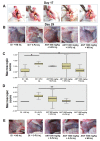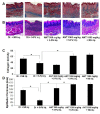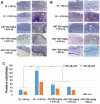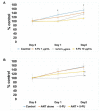Anthocyanins Extracted from Oryza sativa L. Prevent Fluorouracil-Induced Nuclear Factor-κB Activation in Oral Mucositis: In Vitro and In Vivo Studies
- PMID: 30274314
- PMCID: PMC6213925
- DOI: 10.3390/ijms19102981
Anthocyanins Extracted from Oryza sativa L. Prevent Fluorouracil-Induced Nuclear Factor-κB Activation in Oral Mucositis: In Vitro and In Vivo Studies
Abstract
This study aims to investigate the immunomodulatory effect of anthocyanins (ANTs) from Oryza sativa L. extracts on 5-fluorouracil (5-FU)-induced oral mucositis, using a rat model and oral keratinocytes. ANTs were detected by high-performance liquid chromatography (HPLC)-electrospray ionization mass spectrometry. Animals were randomly given varying doses of ANT-rich extract treatment (500 mg/kg and 1000 mg/kg) in the absence or presence of 5-FU-induced mucositis. Buccal mucosae were photographed and scored for macroscopic analysis and incisional biopsies of cheek pouches were collected for microscopic examination of oral mucositis. 5-FU caused marked hemorrhage, extensive ulcerations and abscesses compared to non-treated animals with slight erythema. Histologically, a loss of collagen bundles and inflammatory cell infiltrates was observed. After 29 days of ANT treatment, lesions resolved, and abundant collagen fibers were evident in the lamina propria. Buccal mucosa of 5-FU-injected rats showed increased Nuclear factor-kappa B (NF-κB) p50 and p65 in oral keratinocytes. The administration of ANT reduced NF-κB-positive cells in 5-FU rats (p < 0.001) compared to the non-treatment group. In oral keratinocytes, ANT treatment significantly restored 5-FU-induced growth inhibition and impaired the nuclear accumulation of NF-κB p50 and p65. Our study demonstrated that ANT from Oryza sativa L. exhibited effective anti-inflammatory properties against 5-FU-induced oral mucositis by inhibiting NF-κB activation.
Keywords: 5-fluorouracil; NF-κB; anthocyanin; chemotherapy; oral mucositis.
Conflict of interest statement
The authors declare no conflict of interest.
Figures








References
-
- Logan R.M., Stringer A.M., Bowen J.M., Yeoh A.S., Gibson R.J., Sonis S.T. The role of pro-inflammatory cytokines in cancer treatment-induced alimentary tract mucositis: Pathobiology, animal models and cytotoxic drugs. Cancer Treat. Rev. 2007;33:448–460. doi: 10.1016/j.ctrv.2007.03.001. - DOI - PubMed
MeSH terms
Substances
Grants and funding
LinkOut - more resources
Full Text Sources
Research Materials

